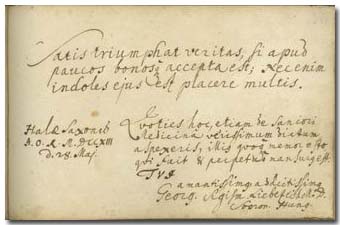
Satis triumphat veritas, si apud paucos bonosque accepta est; Nec
enim indoles ejus est placere multis.
Quoties hoc, etiam de Saniori Medicinâ verissimum dictum
aspexeris, illis quoque memor esto qui fuit & perpetuò mansurus
est TVI amantissimus, addictissimus
Georg. Sigism. Liebezeit. M. D. Sopron. Hung.
Hallae Saxonum A[nno] O[rbis] R[edempti] M.DCCXIII d. 28. Maj. |
|
Truth triumphs enough if she is accepted amongst the few but
right: for it is not her nature to please the many.
Whenever you look at this saying which is
equally valid for a healthier healing, remember him who has been
and will always remain with love and devotion towards you:
Georg Sigismund Liebezeit doctor of medicine
from the Hungariyn Sopron
In Halle of Saxony, in the year 1713 of the
salvation of the world, on May 28.
|
p. 351. Halle,
May 28, 1713
Liebezeit, Georg Sigmund
(1689-1739), physician from Sopron
Georg Sigmund Liebezeit was born on
November 10, 1689 in Sopron, the son of the merchant Paul Liebezeit (who
received his patent of nobility in 1702 from Leopold I) and of Susanna Rosina Launer.
After the local high school, in 1708 he immatriculated at the
academy of Halle. Here he studied with the renowned professors of
medicine of the period, Friedrich Hoffmann (1660-1742), Georg Ernst Stahl (1659-1743),
and his student Michael Alberti (1682-1757), a founder of forensic
medicine. Liebezeit did his examination in this latter subject;
his dispute was published again by Alberti in 1730. Then he went
to Leiden, where he attended the lectures of Herman Boerhaave (1668-1738).
He graduated doctor of medicine in 1713 in Halle. In 1714 he
married Esther Katharina Meissner, daughter of the Lutheran pastor
of Sopron Michael Meissner. He began to practise in Sopron at the
time of the plague. In 1720 he was elected town physician. From
1721 he was a member of the Academia Leopoldina under the name
“Nileus”, and from 1723 member of the Scientific Society of
Berlin. He was in relation with the Hungarian polyhistor of
Pozsony (Bratislava) Mátyás Bél, and supported his great
undertaking of describing the whole Hungary. He died in Sopron, on
November 30, 1739, probably in the renewed plague. He left 1000
forints to his former high school in Sopron. His funeral oration
was addressed by the conrector of the school Dániel Hajnóczy. He
had three children; the godfather of the two daughters was the
Halle professor Georg Ernst Stahl. His works are:
Disputatio medico-legalis de abortus noxia et nefanda promotione.
Quam auspice, quam … praeside D. Michaele Alberti publice
ventilationi exhibet respondens … d. 14. Januar. A. M.DCC.XI.
Halae Magdeburgicae. Halle, 1711. New edition: Halle, 1730. –
Dissertatio inauguralis medica de tumore oedematoso podagrico.
Praes. Stahlio. Halle, 1713.
Liebezeit signed in the album on May 28, 1713 as doctor of
physician. Both his professors in Halle, the chairmen of his
dispute in forensic medicine and in general medicine, Michael
Alberti and Georg Ernst Stahl, wrote in the album in the summer of
1714 (pp. 427,
179).
•
Jöcher-Adelung • Szála • Szinnyei • ÚMIL |

